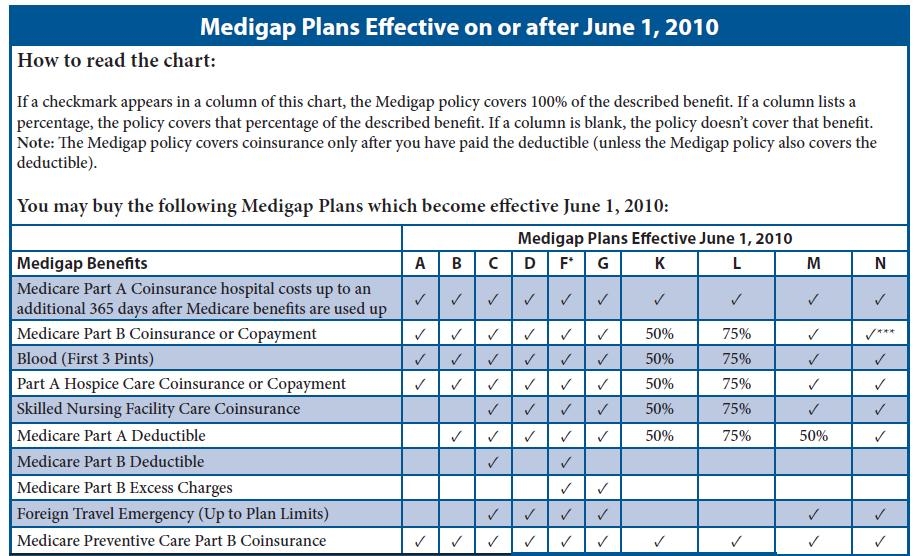What do Medigap Plans Cover?
Learn about what Medigap plans, including what’s paid for or not, and get a comprehensive understanding of benefits with this guide.
Medigap plans are designed to help cover the costs not covered by traditional Medicare, such as copayments, coinsurance, and deductibles. They can also provide additional services not provided by Original Medicare such as coverage for emergency medical care while traveling abroad or at home in the US.
What are Medigap Plans?
Medigap plans, also known as Medicare Supplement Insurance, are health insurance policies sold by private companies that supplement Original Medicare.
These plans provide coverage for copayments, coinsurance, and deductibles not covered by Medicare Part A and Part B. People who purchase Medigap plans are often seniors or disabled individuals who want to pay out-of-pocket costs associated with medical care.
Unlike Medicare Advantage Plans, which replace original Medicare with a different type of coverage, Medigap plans simply help cover the gap between what Original Medicare pays and the actual cost of healthcare services. People enrolled in Medigap plans typically pay an additional premium in addition to their regular monthly premiums for Parts A and B.
Medigap plans are standardized nationwide and come in 10 different plan types—labeled Plan A through Plan N—each one covering a different set of benefits.
The most comprehensive plan is usually Plan F, which covers all of the gaps left uncovered by Original Medicare, including co-insurance payments for hospital stays (up to 365 days) and skilled nursing facility services (up to 100 days).
Other common benefits included in Medigap plans are foreign travel emergency medical care coverage up to 80% of approved expenses (up to $50,000), at-home recovery services (medically necessary such as physical therapy or occupational therapy), and hospice care coinsurance payments.
Some states may offer additional benefits or fewer options than other states; however, regardless of where you live, each plan is required to provide the same basic set of benefits. It is important to compare Medigap plans available in your area carefully so that you get the most suitable coverage for your needs.
For those eligible for Medicare Parts A & B, a Medigap policy can be an attractive option because it helps reduce out-of-pocket costs associated with doctor visits and hospitalizations. Keep in mind that if you choose a Medigap policy you will still need to continue paying your monthly premiums for Part A & B as they are separate entities from Medigap policies.
Finally, when researching your options it’s important to know that some private insurance companies may impose certain restrictions on who is eligible for their policies such as age or pre-existing conditions so make sure to ask any questions before signing up for a particular plan.
What Medigap Plans Cover
Medigap plans, also known as Medicare Supplement Insurance, are insurance policies sold by private companies to supplement Original Medicare.
These plans provide coverage for the copayments, coinsurance, and deductibles that are not covered by Medicare Part A and Part B. Individuals who purchase Medigap plans are typically seniors over 65 or individuals with disabilities.
Medigap plans can vary in terms of monthly premium prices based on the specific services covered and the deductible amount required before benefits are paid out.
However, all Medigap plans must cover certain basic benefits under federal regulations such as:
• Part A coinsurance and hospital costs up to an additional 365 days after Medicare benefits run out
• Part B copayment or coinsurance
• First three pints of blood
• Part A hospice care copayment or coinsurance
• Skilled nursing facility care coinsurance
• Foreign travel emergency health care (up to plan limits)
In addition to these basic benefits, Medigap Plans can provide additional coverage for:
• Medicare Part A deductible
• Medicare Part B excess charges
• At-home recovery (up to plan limits)
• Preventive care (unlimited coverage)
• Excess hospital costs (above Original Medicare’s limits)
Overall, Medigap Plans enable those enrolled in Original Medicare to receive more comprehensive coverage than what is provided by Part A and Part B alone. This type of supplemental insurance provides financial protection against expensive medical bills, which can help reduce out-of-pocket costs associated with medical expenses.
It is important for those considering purchasing a Medigap Plan to consider the range of options available and find the one that best suits their individual circumstances.
What Medigap Plans do not Cover
It’s important to note that Medigap Plans do not cover the following:
– Long-term care services: This includes nursing home care, custodial care at home, and other related services.
– Vision and dental care: It is important to note that most vision and dental care will not be covered under Medigap Plans.
– Private duty nursing: Medigap plans will typically not cover private duty nursing which involves direct supervision of a licensed nurse for 24 hours a day, seven days a week.
– Prescription drugs: Generally, prescription drugs are only covered by Part D of Medicare.
– Hearing aids and exams: Hearing aids and exams are generally not covered under Medigap Plans.
– Routine foot care: Additional payments for routine foot care are usually not included in Medigap Plans.
– Medical expenses incurred outside the United States: Any medical expenses incurred outside the United States would usually not be covered under a Medigap Plan.
What are the 10 Medigap Plans
Medigap Plans are designated in letters that run A – N. Each plan letter has slightly different benefits, and the coverage does not increase as you go through the alphabet in order.
The 10 Medigap Plans are: A, B, C, D, F, G, K, L, M, and N.
There are also high-deductible versions of Plans F and G.
The first type of plan, Medigap Plan A, covers basic benefits such as Part A coinsurance and hospital costs up to an additional 365 days after Medicare coverage has ended. It also covers Part B coinsurance and copayments, blood transfusions, hospice care coinsurance or copayment, and skilled nursing facility care coinsurance.
The other nine types of plans (B through N) cover more comprehensive benefits including Part A deductible, foreign travel exchange emergency coverage, preventative care coinsurance, and at-home recovery.

The Best Medigap Plans
Despite there being 10 different Medigap plans, there really are just a few plans that most people enroll in.
Currently, the most popular Medigap plans are:
- Medigap Plan G
- Medigap Plan N
- Medigap Plan F
The benefit of these plans is that they provide additional coverage for medical expenses that Original Medicare does not cover. This could include things like excess charges when you receive your care from a provider who doesn’t accept Medicare’s approved amount as payment in full or co-insurance payments that you would need to make once you have met your deductible.
Other benefits include covering some out-of-pocket expenses when you receive care at home or outside the United States; emergency transportation services; and extra days in the hospital beyond what is covered by Original Medicare (up to 365).
It is important to note that Medigap policies are offered through private health insurance companies which means premiums may vary between providers though the coverage remains exactly the same regardless of which company it is purchased from.
Additionally, all 10 Medigap plans must follow federal and state laws designed to protect consumer rights such as guaranteed renewability even if you have health problems.
When choosing a Medigap plan it is important to compare multiple policies available in your area so you can find one that meets your needs at an affordable price point – because even though all 10 Medigap plans offer similar basic benefits, there may be subtle differences between them that can make one better than another depending on your specific situation.
Comparing prices from different providers will also help ensure you are getting the best value for money while making sure that any policy you choose still offers adequate coverage for your needs going forward.
Medigap Plan F
Enrolling in Medigap Plan F?
Medigap Plan G
Medigap Plan G is now one of the most popular Medigap plans, especially for people new to Medicare.
With this plan, you don’t have to worry about spending too much on medical bills. In fact, you only have one expense on Medigap Plan G and that is the Medicare Part B deductible. Once this is met you get 100% coverage with Plan G, just like you do on Plan F.
Medigap Plan G offers many benefits that other plans don’t have. For example, it covers all of the out-of-pocket expenses related to Medicare Part A and B services, such as copayments and coinsurance amounts in excess of the deductible amount allowed by Medicare Part A or B.
This means you won’t have to pay anything extra if your medical costs exceed what is covered under your Medicare Part A or B plans alone.
Another benefit of Medigap Plan G is that it covers some expenses not covered by Original Medicare such as travel abroad emergency care and preventive screenings like mammograms and colonoscopies which are important parts of staying healthy but can be expensive without insurance coverage.
In addition, with Medigap Plan G there are no networks so you can see any doctor who accepts original Medicare regardless of where they practice in the United States.
Medigap Plan N
Medicare beneficiaries have access to a variety of supplemental health insurance plans offered by private insurers, one of which is the widely popular Medigap Plan N.
This plan serves to bridge the gaps in traditional Medicare coverage, albeit with some nuances that differ from Medigap Plan G.
Medigap Plan N provides enrollees with access to similar basic benefits as other Medigap plans, including coverage suitable for co-insurance, copays during hospitalization and skilled nursing care, and various medical services such as outpatient surgeries and emergency room visits.
Nevertheless, distinctions exist between Medigap Plan N and other Medigap plans. For instance, this plan mandates enrollees to pay a maximum of $20 during doctor’s visits or emergency room visits after the Medicare Part B deductible is met each year, in contrast to other Medigap plans that assume these costs.
How to Enroll in a Medigap Plan
Here on our website, you can compare Medigap plans and view rates instantly in your area by entering your information on the form to the right.
Finding the right Medigap plan and getting your questions answered has never been easier, as our licensed insurance agents are here to help, all for NO COST to you.
To get started, just give us a call today at 1-888-891-0229.

Updated December 4th, 2022

